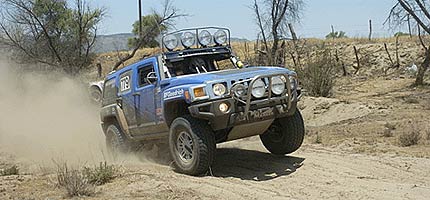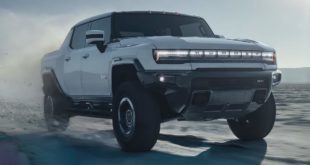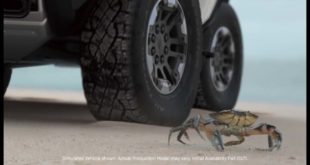
Last week at SEMA we went to the Mile Marker booth only to find out Team Hummer captain and off-road racing legend Rod Hall had left a day earlier. We still lucked into some autographed posters, but it would have been great to meet him in person. Even though we didn’t get a chance to ask him any questions – General Motors recently did – and the transcript is below. Enjoy!
Q. How did you get involved with off-road racing?
A. It’s how I’ve done everything in my life – it’s not according to plan, it’s just by accident. I guess the way it started was when I bought my first four-wheel-drive vehicle in 1956. There was no such thing as off-road racing then. I bought a Jeep; a little CJ-5. It was worn out because that was all I could afford so I quickly learned to become a mechanic. I joined the Hemet (Calif.) Jeep club, and eventually – by default – I became the president.
One of the things I did with the club was probably put on the first off-road race in California in either 1961 or ’62. We had a very large four-wheel-drive trip that we did out around Barstow (Calif.) and I think there was close to 300 Jeeps out there. We set up a course which wasn’t much more than a 17-mile track that just went around this mountain. Very basic, it had a few arrows and stakes to guide people with. Nobody had helmets or roll bars on the Jeeps. Seat belts were about all we had in terms of safety.
Then we did little events where we went up to Colorado Springs or Golden (Colo.) and drove back to Truth or Consequences (N.M.) which were actually the beginning of off-road racing. I would go and do these events, which we called gymkhanas for insurance reasons. But they were still timed events so that’s where it started.
In 1967 we went to Pismo Beach, (Calif.), to put on the Association of Four-Wheel-Drive Clubs’ annual August event. We had hill-climbs, drag races and an obstacle course. We heard about the Baja 1000 coming up in October of that year and my co-driver Larry Minor and I got all excited about it. I went out and bought a brand-new Jeep and we ran the race. I liked it so much I continued to do that every year. Talk about a guy being in a rut – every November I go out and do the Baja 1000…
Q. There aren’t too many 70-year-olds out there racing cars. What keeps you motivated?
A. I think there are a number of reasons. Most importantly, I really enjoy what I’m doing. Off-road racing is a hobby for me and I’m very serious about my hobby. It’s my golf game. Really, I like it a lot and it’s all I really know.
Another big reason is that it’s something I do with my family. My sons, Chad and Josh, race HUMMERS too. If it was just me on my own and I had to do all the prep work and the organization, I would probably consider retiring. It’s a lot of work. We’re taking about 40 to 50 people to Baja with us and somebody’s got to organize and plan everything. But with my boys involved, it’s a lot easier for me to keep going. Plus it’s something we can do together.
Third, off-road racing also enhances my business. We’ve created a decent business with the military, enhancing the suspensions of heavy armored vehicles. The military Humvees have so much armor on them that technically, they are overloaded. The trucks are graded at 10,500 lbs and with armor, they become loaded up to almost 15,000 lbs. That negatively affects suspension components and subsequently the handling of the vehicles. With our 13 or 14 years of experience racing the H1, we were able to offer the military enhanced suspensions for the H1, and it’s led to work on other vehicles as well, such as armored ATVs. I’m a HUMMER dealer as well – I have a dealership in Reno (Nev.) – and the off-road credentials set us apart from other dealers.
Q. What was your most memorable race?
A. That’s hard to really say. I have really fond memories of so many. I get asked the question ‘what is your favorite race’ quite often and all I can think to say, usually, is ‘the next one’. Whether it’s 200 miles or 1300 (this year’s Baja 1000 will run 1300 miles), it doesn’t matter. Of course the Baja 1000 has a special meaning to me because it was my first race.
Q. The ‘premier’ classes in off-road racing are usually the Trophy Trucks. Why did you not pursue that route and stick with stock classes instead?
A. Before I joined HUMMER in 1994, our team was headed in the direction of Trophy Trucks and I was actually thinking about quitting. My expertise was racing production cars and I like that.
Q. So what drew you to HUMMER?
A. Well, I actually didn’t even know what a HUMMER was in 1992. Looking back, I can’t believe I wasn’t aware of that. Back then, a friend of mine told me that the military-only HUMMER was going to come out with a civilian vehicle and they were interested in running the Baja 1000. That friend had some dealings with HUMMER so he set up a meeting for me with Bill Thompson, who was the head of AM General’s civilian division. We met and got along very well – he was a low key guy and we had that in common, or at least I think we did – and he wanted to race a stock car. Dodge, who we were with at the time, was headed in the direction of Trophy Trucks and we parted company very amicably. I just wanted to stick with production cars so the timing was perfect.
Q. How demanding is off-road racing on production cars and how do the HUMMERs handle it?
“Well, people claim the desert is so fragile, but I doubt they’ve been out there pounding through rock washes and hitting tree stumps. There’s nothing fragile about that stuff and it’s really tough on a vehicle. When you race production cars, you first have to understand how much punishment your vehicle can take for a certain amount of miles. Then you drive it accordingly. If someone wants to go running by you in their Ridgeline pickup truck, you just let them go because you know your vehicle can only stand so much. And then you see them working on theirs not much farther ahead. It takes a lot of discipline to race production cars.
All of the HUMMERs – and I don’t care who I’m talking to or who I’m racing for – in my opinion, they are the toughest off-road vehicles off the showroom floor. I’m happy to be racing them.
Q. What is it like racing with your sons?
A. It’s really a pleasure. I didn’t ask them to get involved with me business-wise nor race-wise. I didn’t want to talk them into anything; I wanted it to be their choice and it all worked out really well.
Out of high school, Chad went to college and started flying jets for the Air National Guard and Josh went into the Marines and was shipped to Okinawa. One day Chad came home for the weekend and he went for a ride with me in my truck. And he told me it was more fun than flying jets and asked for a race car. That’s how he got involved. Now he races the H1 Alpha but for the Baja 1000 and beyond, he’ll be fielding an H3 Alpha V8.
Josh was married and had a family and he was pretty busy with his own life. He got out of the military, worked for his father-in-law for a while and after he went racing with us, decided he wanted to do this too. So we built him a car too and became a racing trio. Josh races the H2 at the moment and will switch to the H2 SUT pickup for the 1000 and next year.
Q. Describe the Baja 1000 and the events leading up to it, such as pre-running:
A. It’s going to be 1300 miles this year and that’s without stopping. If the guys want to pass you early in your class, let them go. I’ve been doing this long enough to know that using yourself up in the first six or eight hours is not what you want to do.
Parnelli Jones gave the best description of the race that I’ve ever heard. He said it’s like a plane crash that lasts all day. Well, it’s not really that bad. But it can get rough.
For pre-running, we have an H2 at our dealership that we fixed up as a pre-runner. It’s got roll bars, big shocks and GPS fitted to it so it’s more or less a race car. Mike Winkle, my partner in the HUMMER business and I will be pre-running in that. Josh and Thad Stump will be in an H2 from the GM Proving Grounds in Mesa, Ariz. And Chad will be in an H2, also from the Proving Grounds. We’ll leave Ensenada, Mexico on Sunday morning and end up in Cabo San Lucas on the afternoon of Saturday, Oct. 26. Hopefully we cover enough ground where we can cover some of the sections twice down there. I’ll do some more pre-running after the SEMA show, but won’t go down that far again until the actual race.
Q. How physically demanding is the race?
A. For people that are not used to it, it’s very difficult. It’s strenuous, dirty and hot. You get beat up and used up. I’m used to it; I’ve been doing it a long time and I’m not even sore when I get out of the car anymore.
Q. Do you have a chiropractor?
A. Actually, no. One of the secrets is, as I look back over the history of my racing over 40 years, about the time I say ‘you know what, I’ve just about had it with this stuff,’ we build a new car. The new car rides better and you think ‘I guess I’m okay for a while’. At my age, one of the reasons why I keep racing is that my HUMMER H3 really gives me a comfortable ride. It doesn’t beat me up so I’m able to sit in it for hour after hour, mile after mile and still be in reasonably good shape when you get to the finish line.
Q. Any special preparation for a race?
A. Nothing too major. My ritual is that I really rest up for a couple days before the event. I don’t try to get worked up over anything that’s going on with the team. I spend quite a bit of time by myself and get into the mood of what I’m going to be doing. I think about the race course and I think about the different types of situations we’re going to be in. The day before, I eat properly and try to bulk up a little bit. Pastas, foods with carbohydrates are good for that. I have a really good breakfast before I leave and then during the race, I eat energy bars, bananas and cups of coffee. That sustains me throughout the race.
Q. What do you do to stay in shape?
A. I do some daily exercises – 40 to 50 push-ups every day. I walk a lot. When I travel, I try to stay on the sixth floor in hotels and use only the stairs. Exercise needs to be something that’s continuous, not full-bore for a week and then take a week off. I don’t go to gyms, but I eat right and keep my weight right. I keep my muscles toned and I don’t smoke or drink.
 Hummer Guy Hummer News and Opinion from an experienced off-road instructor
Hummer Guy Hummer News and Opinion from an experienced off-road instructor




oh my god?! is he actually 70?
He will be on Nov. 22. Between he and his sons Josh and Chad, they have more wins at the Baja 1000 than any other family – 26. Eleven of them in HUMMERs!